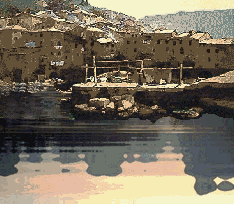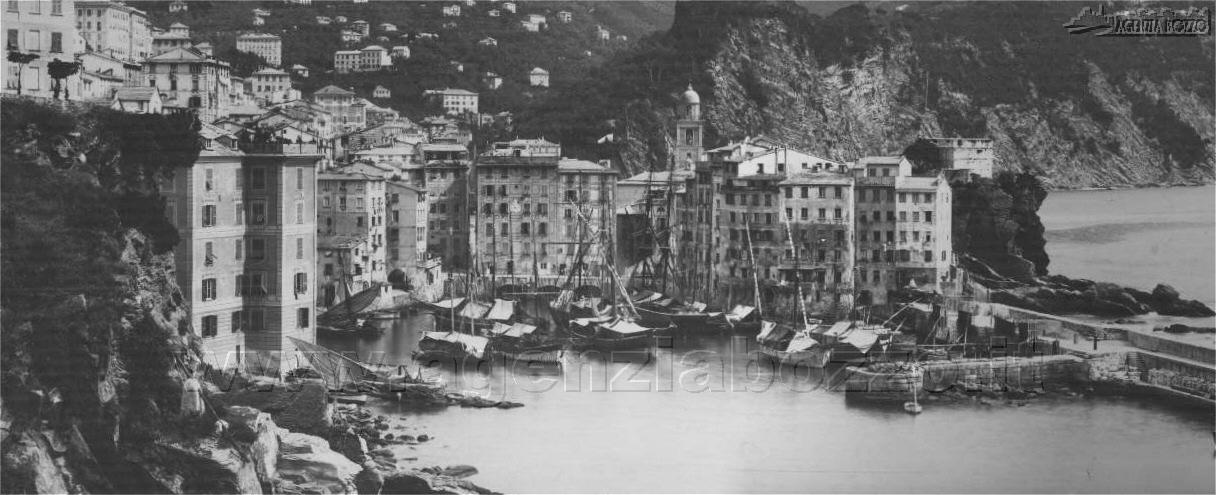|
Ancient Camogli
English text and pictures under revision: click to the italian
version:
http://www.agenziabozzo.it/Ita/Camogli_Ieri.shtm

 

The
Old Camogli Photogallery
The old pictures
here presented have been collected by friends and kindly people, rumming
in old trunks in humid cellars, dusty garrets or between piles of old faded
papers.
Rescued from the insults of the time with the modern
digital techniques, we propose to the attention of the Tradition's Student and
of the curious the fruit of many years of long search and listing.
Our thanks goes to everybody: to the Traditional Group
"U Dragun" (of which I'm a proud member since its foundation in 1969) that gave
its photographic archives at our disposition; to the Camoglini and the
Camogliesi (later in I will explain what's the difference) and to all those who
contributed to the formation and the documentation of this Archive, visible
testimony of the evolution of a Country unique in the world.
Obviously not complete, this collection is in
continuous growth, therefore I ask also your aid. If you possess old pictures of
Camogli, also when break into pieces or slightly visible, and want lend them to
me for their reproduction (without any commercial purpose) I will be pleasing, and
with me all those who will have therefore the possibility to admire a piece may
be unique.
Marcello Bozzo, author
of the collection
|

CAMOGLI in 1846 -------- Excerpt from
PICTURES
FROM ITALY
by Charles Dickens - Bradbury & Evans, London 1846
CHAPTER IX - TO ROME BY PISA AND SIENA
There is nothing in Italy, more beautiful to me, than the coast-road between
Genoa and Spezzia. On one side: sometimes far below, sometimes nearly on a level
with the road, and often skirted by broken rocks of many shapes: there is the
free blue sea, with here and there a picturesque felucca gliding slowly on; on
the other side are lofty hills, ravines besprinkled with white cottages, patches
of dark olive woods, country churches with their light open towers, and country
houses gaily painted.
On every bank and knoll by the wayside, the wild cactus and aloe flourish in
exuberant profusion; and the gardens of the bright villages along the road, are
seen, all blushing in the summer-time with clusters of the Belladonna, and are
fragrant in the autumn and winter with golden oranges and lemons.
Some of the villages are inhabited, almost exclusively, by fishermen; and it is
pleasant to see their great boats hauled up on the beach, making little patches
of shade, where they lie asleep, or where the women and children sit romping and
looking out to sea, while they mend their nets upon the shore.
There is one town, Camogli, with its little harbour on the sea, hundreds of feet
below the road; where families of mariners live, who, time out of mind, have
owned coasting-vessels in that place, and have traded to Spain and elsewhere.
Seen from the road above, it is like a tiny model on the margin of the dimpled
water, shining in the sun. Descended into, by the winding mule-tracks, it is a
perfect miniature of a primitive seafaring town; the saltest, roughest, most
piratical little place that ever was seen.
Great rusty iron rings and mooring-chains, capstans, and fragments of old masts
and spars, choke up the way; hardy rough-weather boats, and seamen’s clothing,
flutter in the little harbour or are drawn out on the sunny stones to dry; on
the parapet of the rude pier, a few amphibious-looking fellows lie asleep, with
their legs dangling over the wall, as though earth or water were all one to them,
and if they slipped in, they would float away, dozing comfortably among the
fishes; the church is bright with trophies of the sea, and votive offerings, in
commemoration of escape from storm and shipwreck.
The dwellings not immediately abutting on the harbour are approached by blind
low archways, and by crooked steps, as if in darkness and in difficulty of
access they should be like holds of ships, or inconvenient cabins under water;
and everywhere, there is a smell of fish, and sea-weed, and old rope.
The coast-road whence Camoglia is descried so far below, is famous, in the warm
season, especially in some parts near Genoa, for fire-flies. Walking there on a
dark night, I have seen it made one sparkling firmament by these beautiful
insects: so that the distant stars were pale against the flash and glitter that
spangled every olive wood and hill-side, and pervaded the whole air.
Charles Dickens
Text and pictures under review: click to the
italian
version:
http://www.agenziabozzo.it/Ita/Camogli_Ieri.shtm
Thank you !
|
NOTE
We lay this collection to the attention of
the interested persons for cultural reasons and without commercial purposes. The
property of the images is classified to respect of the Owners and their
duplication is prohibited under whichever form or shape.
The facts narrated in the captions come
almost from orally related stories that we faithfully transcribed, on which
exactitude we decline every responsibility: we will however retain eventual
completions or corrections coming to us from the interested ones.
In the compilation we have tried the
maximum exactitude possible: in the case the navigator will found eventual
inexactness in the dating or in the attribution of the Authors of the
photographies or inaccuracies in the description, we apologize and we will be
grateful for signalling it.
The photographies introduced here come
from collections and various sources, published with the consent of the
respective Owners: however if the contrary were demonstrated to us, also this will
be considered.



|





